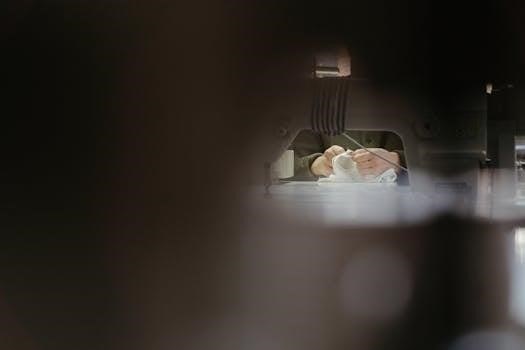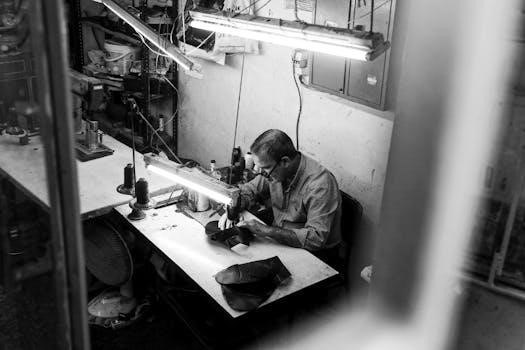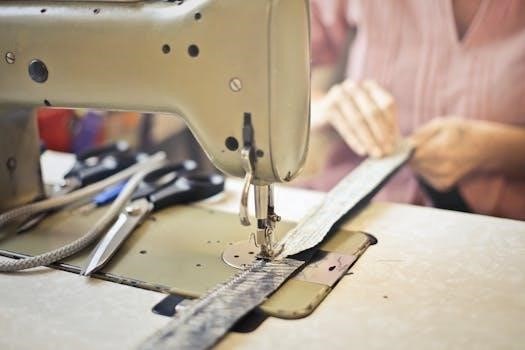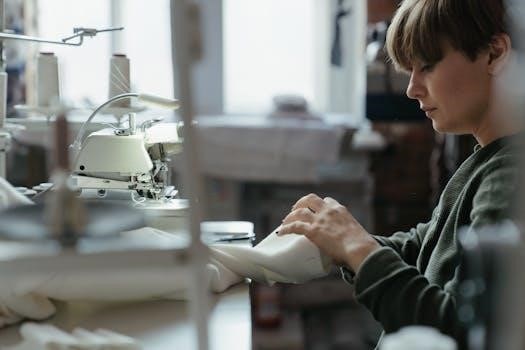Sewing Machine Safety Precautions
Always keep your fingers away from the needle and moving parts of the machine. Ensure the machine is unplugged before threading. Maintain focus during operation and do not treat the machine as a toy, especially around children. Use only recommended accessories. Read the safety instructions in the manual thoroughly before use.
Hand Safety During Operation
When operating a sewing machine, it is crucial to prioritize hand safety to prevent injuries. Keep your fingers well away from the needle area, hand wheel, upper thread tension dial, and pattern selection dial during operation; Never place your hands underneath the needle while the machine is running, even for a moment, as this can lead to serious injury. Always maintain a safe distance, and ensure your fingers are clear of all moving parts. Before starting the machine, double-check that your hands are not in the path of the needle or presser foot. Exercise extra caution when working with small pieces of fabric or when maneuvering around tight corners. Avoid distractions while sewing to maintain focus on your hand placement. If you need to adjust the fabric or thread, stop the machine completely and wait for all moving parts to come to a halt. Remember, a moment of inattention can result in a painful accident, so prioritize caution and hand safety at all times during sewing machine operation.
Proper Needle Plate Usage
The needle plate, also known as the throat plate, is a vital component of your sewing machine, and using it correctly is essential for safe and effective sewing. Always ensure that you are using the proper needle plate for the type of sewing you are doing. Using an incorrect plate can cause issues with fabric feeding and can even damage the machine. The needle plate should be securely attached before starting any sewing project; Regularly inspect the needle plate for any signs of damage, such as scratches or dents, which could affect the fabric’s smooth movement. When changing the needle plate, refer to your sewing machine manual for the correct procedure. It is crucial to align the needle plate properly to prevent the needle from hitting the plate, which could lead to breakage or damage. Proper usage of the needle plate will ensure consistent stitch formation and prevent fabric from getting caught. Always keep the needle plate clean and free from lint to maintain optimal performance. Never sew without a needle plate.

Threading and Preparation
Proper threading is key to successful sewing. First, wind the thread onto the bobbin correctly. Then, thread the top part of the machine, following the manual carefully. Ensure fabric is positioned correctly before starting;
Bobbin Winding Process
The bobbin winding process is a crucial first step in preparing your sewing machine for use; Begin by placing the thread spool on the thread spindle, ensuring it’s securely positioned. Next, guide the thread through the designated thread guides, usually indicated by arrows or markings on your machine. These guides help maintain proper tension and prevent tangling. Then, wind the thread around the bobbin several times by hand to secure it. Once secured, place the bobbin onto the bobbin winder spindle. Engage the bobbin winder mechanism, usually by pushing a lever or moving a slider. With the machine powered on, gently press the foot pedal to start winding. Monitor the bobbin as it fills, stopping when it reaches the desired level. Avoid overfilling to prevent issues during sewing. Finally, disengage the bobbin winder, remove the bobbin, and you are now ready to insert it in the bobbin case.

Correct Threading Techniques
Correct threading is essential for smooth and consistent sewing. Begin by raising the presser foot and needle to their highest positions. Place the thread spool on the spool pin and guide the thread through the designated thread guides, following the numbered path indicated on your machine. Each guide plays a role in maintaining proper thread tension and preventing snags. Next, thread the upper tension disc, making sure the thread nestles securely between the discs. Then, pass the thread through the take-up lever, ensuring it engages properly. Now, guide the thread through the remaining thread guides before finally threading the needle from front to back. Leave a tail of thread about six inches long. Remember, proper tension is key to prevent looping, skipped stitches, and thread breaks. Check your specific machine’s manual for any variations in threading paths, since they can differ between models.

Sewing Machine Manuals Availability
Many manufacturers provide downloadable manuals on their websites. Third-party resources also offer manuals for various brands, often for free. These resources are essential for correct operation and maintenance of your sewing machine.
Manufacturer Websites
The primary and most reliable source for obtaining sewing machine manuals is directly from the manufacturer’s official website. Major brands such as Singer, Janome, Brother, PFAFF, and Husqvarna Viking typically host comprehensive libraries of product manuals in digital formats. These manuals are usually available for free download, often in PDF format, making them easily accessible on various devices. Navigating to the support or customer service section of the website is generally the first step in locating the specific manual for your sewing machine model. These resources frequently include detailed diagrams, troubleshooting tips, and safety information, ensuring users have everything they need for proper use and maintenance. Manufacturer websites are continuously updated with the latest versions and new models, making them an invaluable tool for both new and seasoned sewers. The advantage of using the official site is that you’re guaranteed to receive the correct manual, avoiding compatibility issues and potential misinformation. Using these sites ensures you have access to the most current and accurate information regarding your specific machine, allowing you to sew with confidence.
Third-Party Manual Resources
Beyond manufacturer websites, numerous third-party resources offer sewing machine manuals. These sources can be particularly useful for locating manuals for older or less common machine models that might not be readily available on official sites. Websites specializing in sewing machine manuals often maintain extensive archives, sometimes including brochures and service manuals alongside instruction guides. These sites can provide a valuable resource for users seeking manuals for vintage or discontinued machines. Some resources offer manuals as free downloads, while others may require a small fee. It is important to exercise caution when using these third-party resources, ensuring the source is reputable and that the provided manual is compatible with your machine model. Always verify the legitimacy of the source and the manual before relying on it for operation or maintenance guidance. Additionally, these platforms may offer manuals in various languages, catering to a diverse range of users. These resources include freemanuals;com, themanualsservice.com, and fresewingmachine manuals.com, which are examples of sites where you can find manuals. Always check multiple sources to ensure you have the correct and complete manual for your sewing machine.

Specific Sewing Machine Models
Instruction manuals are essential for specific models. For instance, Singer 248-2 and Singer 28k type machines have unique guides. Accessing the correct manual ensures safe and effective operation of each particular sewing machine.
Singer 248-2 Instructions
The Singer 248-2 sewing machine instructions are typically found in an 18-page English manual. This manual provides comprehensive guidance on using and adjusting this specific model. It is essential for users to consult this manual before operating the machine to ensure correct threading, bobbin winding, and other crucial procedures. The manual will often detail specific maintenance steps, troubleshooting tips, and safety precautions that are specific to the Singer 248-2. These instructions are imperative for both beginners and experienced sewers alike, as they outline the nuances of the machine’s operation and ensure proper functionality. Many online resources, such as themanualsservice dot com, offer these manuals for download. Utilizing the appropriate manual is paramount for maximizing the sewing machine’s performance and longevity and avoiding any accidents or issues. Always refer to the manual for proper usage and any necessary adjustments.
